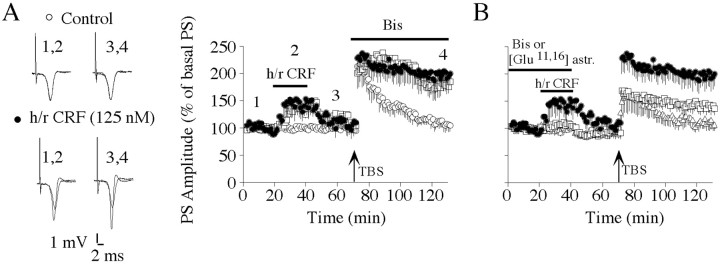Fig. 1.
h/rCRF-mediated facilitation of PS-LTP persistence is prevented by the inhibition of CRF receptors and PKC.A, Left, Representative recordings performed before (1), during (2), and after (3) h/rCRF application and 1 hr after tetanus (4).Traces represent the average of six recordings.Right, A 20 min h/rCRF application (125 nm; ●) transiently increased population spike amplitudes and subsequently enhanced the persistence of PS-LTP induced by TBS compared with controls (○). The selective PKC inhibitor BIS-I (1,2 μm; ■) was bath-applied for the rest of the experiment. This treatment had no effect on PS-LTP persistence. B, Preincubation of slices with BIS-I (1,2 μm; ■) for 1 hr markedly prevented the h/rCRF-mediated increase (125 nm; ●) of population spike amplitudes and subsequent priming of hippocampal PS-LTP. Preincubation of slices with the CRF receptor antagonist [Glu11,16]astressin (500 nm; ▵) for 40 min completely blocked the h/rCRF-mediated increase of population spike amplitudes and the facilitation of TBS-induced PS-LTP. Data are presented as mean ± SEM.

